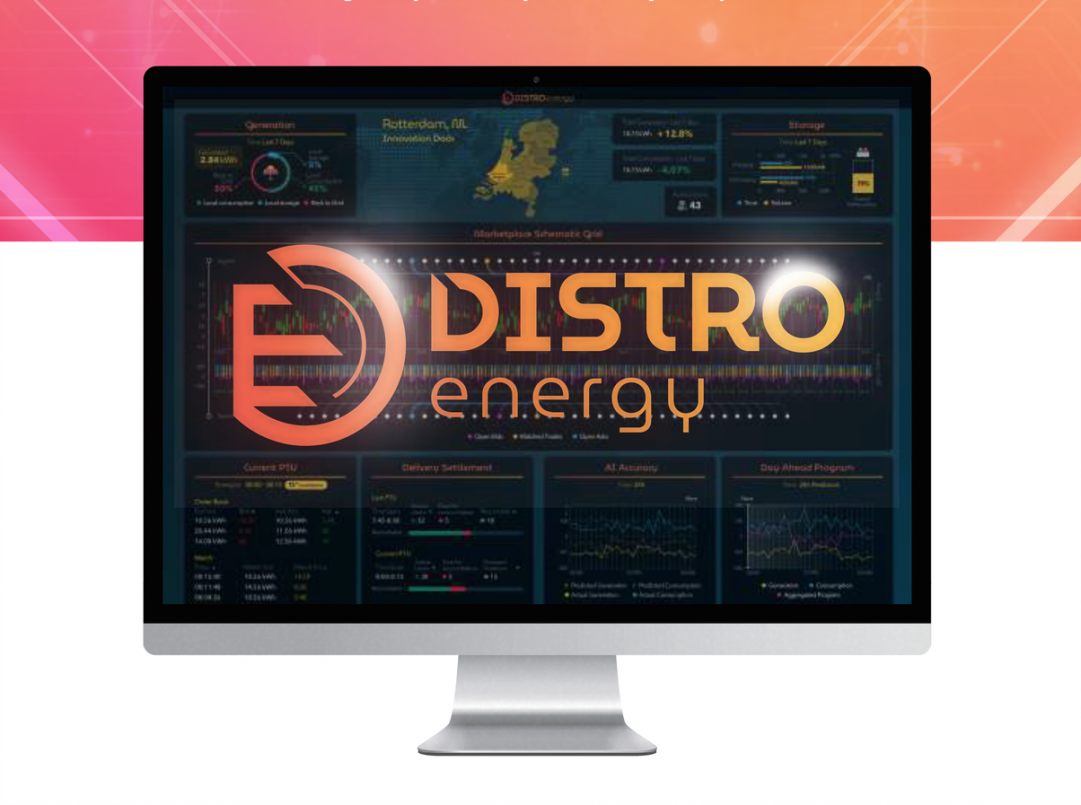The first high-frequency decentralized energy trading platform was successfully piloted at the Port of Rotterdam. Jointly developed by S&P Global Platts and BlockLab, Distro is a new microgrid electricity trading platform that leverages both Artificial Intelligence and Blockchain’s distributed ledger technology.
Under the ongoing trial that commenced in August 2020, commercial energy consumers in the Port of Rotterdam’s iconic innovation dock, where the world’s largest submarines once used to slip off the ramp, used the Distro microgrid trading platform to actively trade renewable energy derived from solar and battery storage, matching demand with intermittent power generation. The results of the trial saw:
• Establishment of dynamic local energy prices that lowered the cost for energy users by 11%, while offering a 14% improvement in revenues for local producers of renewable energy.
• 92% consumption of on-site solar generation, overcoming historic wastages
• 32 commercial energy consumers utilized the fully automated AI trading marketplace to balance local electricity demand and supply
• Battery storage return on investment increased 20%
• 20 million blockchain-validated, cleared and settled transactions
• Once fully scaled across the Port of Rotterdam’s activities, Distro’s transparent market design has shown the potential to support businesses in delivering carbon reduction saving of up to 30 million tonnes
During the trial, the participant buyers and sellers of renewable energy were able to access dynamic local energy prices that reflects their supply and demand balances. The responsiveness of localized prices encourages buyers to consume less when renewable generation is low by holding off until more plentiful supplies are available and in doing so, benefit from lower prices. The unique system builds upon proven practices in commodities and financial market, repackaged for the AI world. The positive results of the pilot validate the technical and commercial potential for Distro to be deployed in other locations around the world.
Nico van Dooren, Director New Business Development & Portfolio, Port of Rotterdam said: “The successful completion of our trial of the Distro new microgrid trading platform is a win-win in encouraging fair and transparent prices as well as cost efficient consumption of renewable energy for our tenants. Balancing local electricity needs with local generation holds the key to unlocking significant grid infrastructure savings. We are excited about the prospects of scaling this solution and the meaningful contribution it can make towards helping The Port of Rotterdam become carbon neutral by 2050.”
The new Distro trading platform was co-developed by S&P Global Platts, the leading independent provider of information and benchmark prices for the commodities and energy markets and Blocklab Rotterdam, the Port of Rotterdam’s blockchain innovation hub. Distro’s rule based methodology draws on Platts 100 year experience of assessing commodity prices around the world.
“The blending of high frequency AI trading capabilities with the benefits offered by blockchain security is a landmark achievement. Distro brings seamless and tangible benefits of lower prices, improved payback on batteries and solar panels while maximizing the use of renewable energy,” said James Rilett, Head of Innovation, S&P Global Platts. “Market feedback has highlighted the need for a new generation of marketplaces, like Distro, to be at the forefront of addressing climate change by helping power energy transition projects around the world.”
Distro offers users in the Port of Rotterdam robust prices that instantly respond to changes in local supply and demand fundamentals while providing incentives for consuming and storing energy. The platform draws on proven security offered by blockchain smart contracts which uphold market rules, validate transactions and manage identities to ensure reliability and anonymity in the dynamic trading environment. All transactions are immutable and cryptographically verifiable, standing up to industry-level audit requirements.
The platform provides every market participant with an AI enabled ‘energy trading agent’ software tool that learns the user’s energy needs, preferences and behaviors. It analyses billions of data points in real-time, automatically buying and selling energy at the best price for the user. ABN AMRO’s Banking as a Service sandbox provided a seamless banking environment where virtual accounts were attributed to users and executed transfers as instructed by the marketplace.
Janjoost Jullens, Director, BlockLab Rotterdam said: “Working with the Port of Rotterdam and S&P Global Platts forced us to focus on business reality and meeting industry standards. We are very proud we can now equip the emerging decentralized power markets with the tools of professional electricity traders – driving up their returns on renewables and minimizing infrastructure investments needed.”
Traditional power grids have come under increasing strain arising from supply-side volatility and ultimately rising costs as the world transitions towards electrification and addresses renewable energy targets. Decentralization alleviates the need to add expensive power grid infrastructure by aligning local demand with supply on the power distribution network, through incentives for demand response due to shifts in energy usage or battery charge/discharge. As renewable generation can vary second to second, these incentives change in real time.
























